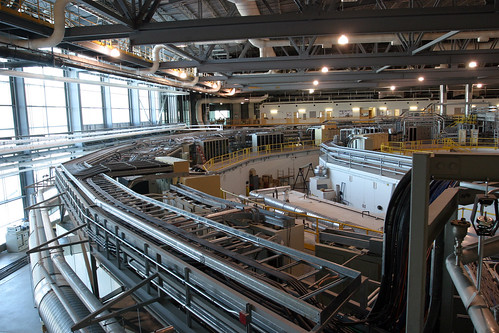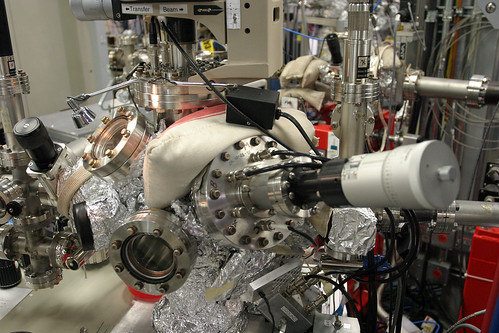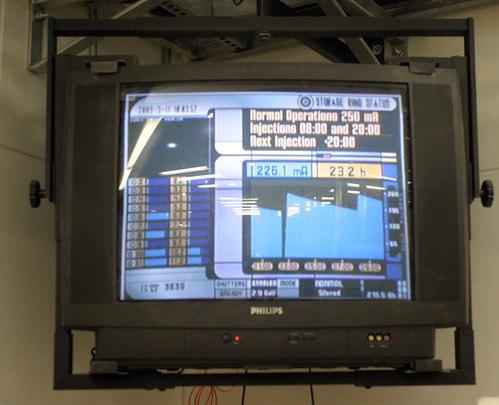Sup peeps! As previously mentioned, here are a few photos from the Canadian Light Source. The CLS is a third generation 2.9 GeV synchrotron located in Saskatoon, Saskachewan. And it's friggin' awesome: 
That's a view of the ring from the north end. The outer donut ring shaped structure is the hutch that covers the storage ring (where electrons go screaming around in a circle, spewing out photons all willy nilly). The inner shaped donut is the injection ring, which spits electrons into the storage ring twice a day to maintain a current of ca. 250 mAmps.
I can't claim to understand much of how synchrotron radiation is produced or the reasons behind its awesomeness, but Wikipedia sure can. For my purposes, synchrotrons are frigging awesome at producing metric buttloads of photons over a huge energy range, making them ideal for any kinds of spectroscopy. Furthermore, they usually are coupled with state-of-the-art optics systems to harness that light, such as monochromators and detectors. This makes science a very happy person.
Positioned tangentially around the outside of the ring, are beamlines optimized to look at certain ranges of photon energies (measured in electron volts) for a range of applications. The CLS has six operational beamlines ranging in energies from the far IR to extremely high energy X-rays (up to 40,000 eV!), with another five almost ready and two more in the wings. This photo above is of the Spherical Grating Monochromator (SGM) and Planar Grating Monochromator (PGM) beamlines, which together cover the soft X-ray energy range (from about 5 to 2000 eV). X-rays are of sufficient energy to cause changes in the electronic state of a material; basically, the photon headbutts a core level electron (like, say, one occupying a 1s orbital), causing it to jump into a valence electron. These transitions require just the right amount of photon energy, depending on the atom and orbitals involved. In the energy range covered by the SGM and PGM beamlines at the CLS, there are a lot of elements that will absorb the X-rays, so much so that the beamline has to be kept under high vacuum so that X-rays will reach your sample. 
The above picture is of the analysis chamber on the PGM. The sample is held in the middle of the vacuum chamber, where incoming photons will hit it, causing X-ray fluorescence or other relaxation events to occur such as Auger electron emission. There are several detectors inside the chamber to record these relaxation events; the X-ray fluorescence detector is attached to the grey cylinder upon which the lamp sits in the photo above.
Running these types of experiments at a synchrotron is pretty dang complicated. As I mentioned above, the beamline has to be kept under high vacuum the whole time; Loading and pumping down your samples can be a rather time consuming process. As well, since time at any synchrotron is in extremely high demand, they run the beamlines 24 hours a day, 7 days a week. People run their experiments as fast as they can during their beamtime. It's the norm to work in shifts around the clock so that you are continually running samples. This can make for a rather wearying work schedule; I usually sleep about 8 hours over 2 and a half days and that's with two other grad students trading shifts.
However, the synchrotron sometimes don't always want to stick to that schedule. Being driven by a collosal number of power supplies, vacuum pumps, water coolers, etc etc that are prone to malfunctioning, there are a lot of factors that can contribute to a loss of beamtime. Usually it gets fixed almost immediately by the engineering staff, but sometimes it can be hours if not days if there's a major glitch. Last year a smoke alarm got tripped accidently, immediately cutting power to the whole ring and putting all research out of commission for three days! That's pretty much a lifetime at a synchrotron.
Anyway, they graph the beam stability on televisions scattered around the building, plotting beam current versus time. That sharp drop on the graph = "injection problems". That immediate spike back up = engineers doing their thang. The CLS as of late has been really really stable *knock on wood*. Hopefully as it continues to mature it will be able to maintain such a high level of excellence!
Since the CLS is located in Saskatchewan, a province with extremely strong roots in agriculture, and because the University of Saskatoon has a world class Vet School, it is involved in some pretty funky research areas, including a beamline set up to analyze live animals! It uses an imaging technique known as diffraction-enhanced imaging, and actually just recently acquired its first images of an animal.
Anyway, I'm back from an exhausting but rewarding trip. Sorry for clogging up all your internet tubes with a giant synchrotron post!
Friday, March 13, 2009
the canadian light source
Wednesday, March 11, 2009
synchrotron!
Sup peeps! I'm at a friggin' synchrotron!
No. not that kind of tron. But it's great to be back!
It's 2 AM, we're trying to process as many samples as we can, and I have consumed about 6 cans of energy drink beverage and 10 turkey pepperoni sticks. I do what I have to get by, what can I say.
If there's a little down time, I may wander around and take some pictures. Holla.
Wednesday, August 27, 2008
IFEFFIT FTW
Currently listening to: Bon Iver- For Emma, Forever Ago
I'm currently sorting out scads and scads X-ray absorption spectra from our recent trip to the Canadian Light Source. It's slow going (loads of calibrations with standards, bleh, sorry jöns, but that's really not my cup of tea).
Anyway, I thought I'd take a short break to give a shout out to Matt Newville, genius and creator of the IFEFFIT software suite I'm using to crunch numbers.[1] 
IFEFFIT is an open-source set of tools for the X-ray spectroscopist, namely for XAFS, though it is very powerful for NEXAFS/XANES as well. For those of you scratching your heads about all of those acronyms, XAFS--aka, "X-ray Absorption Fine Structure"--is a spectroscopic technique for element-specific information on bonding, coordination number, etc. You can use it on compounds where you normally could not do X-ray crystallography/ EELS/RHEELS- gases and liquids, all kinds of amorphous stuff (including nanomaterials) and even on things like surfaces (that's called SEXAFS).
Analogously to crystallography, XAFS can be incredibly mathematically complex and involves a ton of modelling. Newville's software has some bad boy meaty algorithms for dealing with that buffet of data.
The cool thing about IFEFFIT is that Newville (and the other developers, listed below) are actual users and scientist who have successfully used this technique. XAFS requires a lot of number-crunching, but it also needs a keen chemical intuition. Newville has a long list of publications where he's looked a lot of actual chemistry problems.
IFEFFIT also has a very strong user community, where you can post questions and get smart answers quickly-- sometimes even from Newville himself.
It's a huge help to me in my research, and all in all I imagine the software development to be somewhat of a thankless job when you're giving it away for free(for comparison's sake, another piece of software I use quite a bit, ChemDraw, wants me to pony up at least $800 to draw pretty pictures! And don't even get me started on the other tools of the trade. Sheesh!) Hats off to you, Matt Newville.
[1] Other significant contributors to XAFS data processing are Bruce Ravell (who developed the GUI for IFEFFIT you see above on my mac ), Sam Webb and Shelly Kelly.
